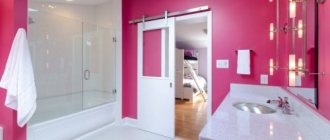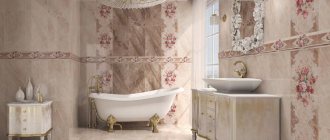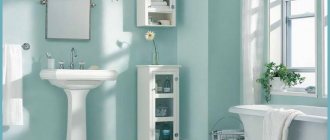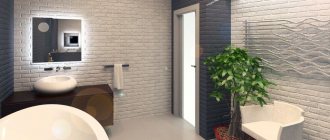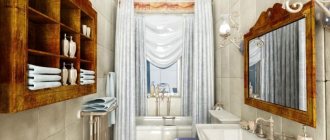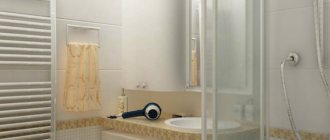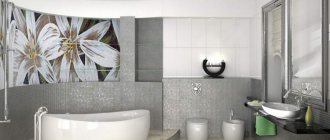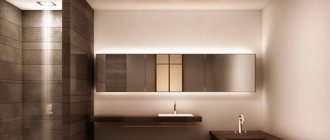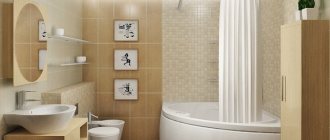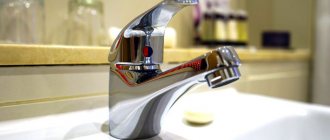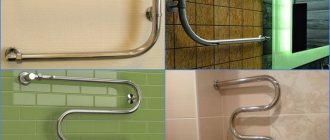An old heated towel rail in a bathroom often does not look aesthetically pleasing. Most often, it is completely out of touch with the overall picture and negates the efforts of designers and builders. He will always attract attention to himself and spoil the mood of the apartment owners. Maybe it's time to break up with him? Moreover, today there are plenty of “coils” on sale of various designs and shapes that will fit much better into your interior than an “antediluvian” pipe. How to choose a heated towel rail for the bathroom, which type to choose, how to install it correctly - we will try to answer all these questions in as much detail as possible.
Installation of an electric heated towel rail
The technology for installing an electrical appliance is not too complicated, so you can easily handle it yourself. The product is mounted on the wall and connected to the electrical network. For the latter, you can use an existing outlet or install hidden wiring from a distribution box.
Instructions for connecting an electric heated towel rail:
- Prepare the necessary tools - a drill, a tile drill, a building level, a tape measure, a marker and a voltage tester or an indicator screwdriver.
- Decide how you will connect to your home network. If the repair is at the stage of laying communications, it is better to lay a separate wire from the junction box. This is a safer option. If a replacement is being made in an already renovated bathroom, then this option will not work without destroying the lining, and this is completely unnecessary. In this case, it would be more correct to connect to an existing outlet. This option is more dangerous, but provided that the outlet is chosen correctly - with a waterproof casing, the height of its installation is correctly calculated and located at a sufficient distance from the water, there will be nothing to be afraid of.
- We are preparing the wall for installation. It is necessary to mark the places for installing the fasteners and make sure that the points are at the same height. You can check this using a building level.
- We drill holes and hammer dowels into them.
- We assemble the heated towel rail according to the drawing in the instructions.
- We connect the wires to the terminals of the device, having first turned off the light in the panel.
- We install it - attach it to the wall and tighten the screws.
- We turn on the machine in the panel.
Plasterboard box
To hide the old heated towel rail, you can use moisture-resistant plasterboard. The manufacture of the box is carried out in the following sequence:
- level the wall near the coil using putty;
- prepare box templates and cut the material;
- fasten the frame parts with self-tapping screws;
- cover the front part with a single sheet, having previously made ventilation holes in it, or install a ready-made grille that will provide access to warm air;
- fix the profile to the wall using European screws or dowels;
- putty the heads of the screws and cover the edges of the box with plastic corners;
- paint the box.
The finished box should not fit tightly to the pipes; to do this, leave a gap of at least 3 cm wide.
A heated towel rail is a useful and convenient device that needs to be maintained in perfect condition.
Combined
This option combines the advantages of the previous two types of products and can provide operation in any of the two modes. The cost of such heated towel rails is quite high.
By assessing the advantages of each type of device and your needs, you can choose the most suitable option.
How to choose correctly
Different types of heated towel rails have their own important characteristics.
When choosing a water model, you should pay attention to the following nuances:
- compliance of the radiator parameters with the level of both operating and pressure testing up to 6 atmospheres or more;
- quality of material;
- the presence of an anti-corrosion layer inside the pipe;
- number of welds;
- design;
- color.
When purchasing, check the presence of all necessary components and purchase missing parts.
Keep in mind that imported water products are not designed to be connected to a hot water supply system and may not cope with the water pressure. Today there are plenty of options on the market from Russian companies, whose products are not inferior in quality and appearance, and have a high rating. For an overview of popular models, watch the video.
Coloring
When carrying out repair work, they often try to hide an old-style heating device. Rust and repeated painting over time make its surface lumpy and shapeless. This can be very difficult to fix.
To put the heated towel rail in order, you need to clean its surface with sandpaper. When choosing paint, you should remember that ordinary paint for walls and floors will not work, because under the influence of temperature it will quickly crack and fall off. The best option is silky-glossy, alkyd and acrylic enamel or water-dispersion paint. These materials are resistant to temperature changes and high humidity, dry quickly, and are safe for the human body.
The color of the coating depends on personal preference. The most popular shades are bronze, chrome, gold, greenish, turquoise or pink. Designers do not recommend using white paint, as after a few months it will lose its aesthetic appeal and acquire a yellowish tint.
Design radiator Jaga Deco
The Jaga Deco design radiator is reminiscent of a horizontal plank fence in the spirit of European villages. If you choose such a radiator in cream and pastel shades, it will become a harmonious addition to the Provence style.
Types - their advantages and disadvantages
Today, manufacturers offer 3 main types of heated towel rails - water, electric and combined. Each of them has its own characteristics, advantages and disadvantages. Let's look at each of them in more detail.
Water heated towel rail
They are a “coil” of various configurations or combinations of pipes through which hot water circulates.
Advantages of water systems:
- You can connect it in place of the removed coil.
- Economical because it does not use electricity.
- Does not require installation of additional cables or special sockets.
Flaws:
- To install, you will have to obtain permission from the housing maintenance service.
- Connection to heating and hot water systems is possible only, so the choice of location is strictly regulated.
- When the hot water is turned off or at the end of the heating period, it ceases to perform its functions.
- There is a high risk of leakage.
A water heated towel rail is suitable for those who simply want to replace an old device with a newer one - aesthetic and modern, installing it in the old place, or seek to limit electricity consumption.
A wide variety of models of water appliances allows you to choose a dryer to suit any design. Traditional U-shaped and M-shaped snakes are worthy competition from ladders with and without shelves for storing towels.
Each connection increases the risk of leakage, so you should choose a product with a minimum number of welds.
Electric heated towel rail
The system can operate autonomously without connecting to a source of hot water - heating is provided by an electric heating element. This allows you to place the battery on any free section of the wall in the bathroom. This is far from the only advantage of an electric heated towel rail. Among the positive characteristics of the device are:
- no permit required;
- easy to install;
- has a temperature regulator, which allows you to set the mode at which it will be comfortable;
- can be used in any season - even when there is no heating or hot water. With its help, your bathroom will be warm and cozy even in the off-season;
- There are economical models that can operate without shutting down and at the same time consuming a minimum amount of energy;
- quickly heat the room;
- can fit into any design due to the wide variety of models.
Among the disadvantages are:
- constant electricity consumption, albeit in small quantities;
- the need to lay wires and install a new socket with a special cover. It protects contacts from flying splashes.
If you do not want to depend on heating and hot water supply, choose an electric heated towel rail with a sufficient protection class for installation in the bathroom.
Electrical appliances are not only wired, but also oil-based.
Advantages of oil dryers:
- They do not require connection to hot water and central heating.
- Keeps warm for a long time.
Weak sides:
- heavy because it contains oil inside;
- the heating element must be constantly surrounded by oil, so it is located at the bottom;
- the system takes a long time to warm up;
- increase in electricity consumption.
Combined
The combination device is a combination of water and electric varieties. A heating element is inserted into the water coil, which can be turned on during periods when hot water is not supplied. With this device your bathroom will always be comfortable. But this type of heater has a significant drawback - it costs slightly more than conventional models.
Installation of a water heated towel rail
When planning to replace a heated towel rail, you must contact the Management Company in advance with a request to shut off the hot water riser. The application must indicate the time of completion of the work.
After making sure that there is no water in the riser, you can begin to dismantle the old device and directly connect the new one.
Installation steps:
- Bypass installation. The design is a jumper made of polypropylene pipe. It is necessary when you need to turn off the water without contacting the management company. This is an indispensable element of the system, which can be a great help if there is a leak or you need to replace the heated towel rail. It is attached to pre-installed ball valves, which can be closed in case of force majeure. At the same time, the circulation of water in the riser will not stop. Air may accumulate in the system. Therefore, a ball valve should also be installed in the jumper itself. Thanks to this, it is possible to ensure unhindered circulation of water in the coil.
- Installation. The requirements for connecting the coil are described in SNiP 2-04-01-85. Polypropylene pipes are welded to the bypass ball valves, which are subsequently connected to the heating device. The structure is mounted on the wall and connected to the laid pipes. The system is secured with supporting brackets to protect the walls from excessive loads that may arise due to deformation of the heating pipes for supplying and discharging water. A distance of 35 cm must be maintained between the heated towel rail and the wall for pipes with a diameter of up to 23 mm, and 50 mm for wider pipes. The supply riser is connected to the socket located in the upper part of the device.
During installation, do not forget that the supply pipe must be installed at a slight slope of about 5-10 cm in the direction of water movement.
- System testing. After installation, it is necessary to check the connections for leaks. Turn on the water and carefully inspect all welds. The connections must be completely dry.
Material
The material for the manufacture of heated towel rails can be various types of metals or their alloys. And depending on which one was chosen for production, the service life and wear resistance of the product may differ.
Heated towel rails are made from:
- black steel is the most budget option, and that’s where its advantages end. The fact is that products made of black steel do not have an internal anti-corrosion coating and are not sufficiently resistant to the effects of the aquatic environment and coolant. It is better to choose such systems for private houses with autonomous heating, where there is no high pressure and differences;
- Stainless steel is the most popular and popular type of coil. This is both a budget-friendly and at the same time reliable material that will last a long time. It is precisely because of its affordable price and durability that it is recommended to be installed in apartment buildings. This heated towel rail is a product without welded seams, and therefore has the ability to withstand high pressure, which is so often found in central water supply systems. Products may be painted, chrome-plated, or plated with materials that appear to be bronze or brass;
When purchasing a stainless steel combination heated towel rail, make sure that its walls are no thinner than 3 mm. A product with too thin walls will not last long, and its heat transfer will be lower.
When purchasing, carefully inspect the joints for defects. An overly budget price may be due to the low quality of the product;
- copper is one of the most reliable options, but far from the cheapest. Despite their light weight, copper products have high thermal conductivity and resistance to corrosion. They are excellent for connecting to both a central and autonomous hot water supply system, as they can withstand high water pressure well. Copper heated towel rails are an excellent accessory that can decorate any interior, especially in combination with copper fittings;
- brass - has characteristics similar to copper - has excellent heat transfer and resistance to the aggressive effects of water. However, it should be borne in mind that the imported brass products on the market today are not able to withstand high water pressure in apartment buildings. Therefore, it is better to use them in autonomous heating systems.
Whatever heated towel rail you choose, always carefully study its characteristics and installation instructions.
Installation location
The location of electric heated towel rails depends on the output of the electrical source. Their location must be determined at the design stage. Then, when laying the wiring, it will be possible to bring out the wires exactly in the place where the device will be located. If the finishing is complete or you are replacing the old radiator, the new one will have to be hung next to the existing outlet.
For water and combined models the situation is somewhat more complicated. Here you need to focus on the location of the hot water supply pipes. Often a sink is placed next to them and you have to hang a heated towel rail directly above it, which is very inconvenient. If the device is connected to the heating system, as a rule, choose a place opposite the bathtub. Another good placement idea is above the washing machine. The worst option is above the toilet when it comes to a combined bathroom. Towels can fall and get dirty at any time. It is also better not to place a radiator above the bathtub, as splashes of water will fall on the towels.
Features of size and shape
The design features and dimensions of the radiator directly affect the aesthetics of the bathroom, the efficiency and reliability of the device and the comfortable conditions in the room. The photo shows the most common models.
The main forms of heated towel rails and their dimensions:
- U-shaped. The most compact models are perfect for small spaces. As a rule, they are installed by developers, since this is the most budget option. It should be noted that water dryers of this type are superior to some expensive models in terms of safety. The fact is that they do not have welded seams, and the risk of leakage is minimized. The products have a standard width of 40-80 cm, and their height is 32 cm.
- M-shaped. Like the previous type, they consist of one element, which means they do not have joints where leaks most often form. Their height is twice as high as the previous ones and is 50-60 cm, and the width is standard. Such products will fit perfectly into the design of a spacious bathroom and create comfortable conditions for its owners.
- S-shaped - it is often called a “snake”.
- Foxtrots. In this embodiment, the U-shaped structure is complemented by a wave-shaped pipe. Due to this, its area and efficiency increases. It has an interesting twist to any project. They are produced in heights from 32 to 60, and the standard width is 40-80 cm.
- Ladders. They are distinguished by large dimensions. Their minimum height is 50 cm, and their maximum is 120 cm.
In a small room, an overly large heated towel rail will look bulky, so when choosing a product you should take into account not only its appearance and compliance with the design of the room, but also the dimensions of the bathroom.
Beautiful classic models
Classic models most often come in two types:
- Coils are most often made in the shape of the letters M or P with rounded edges . Comfortable and suitable for the interior of any bathroom.
- U-shaped heated towel rails are made in the shape of the letter U with rounded edges. Some models are created with a coil inside .

